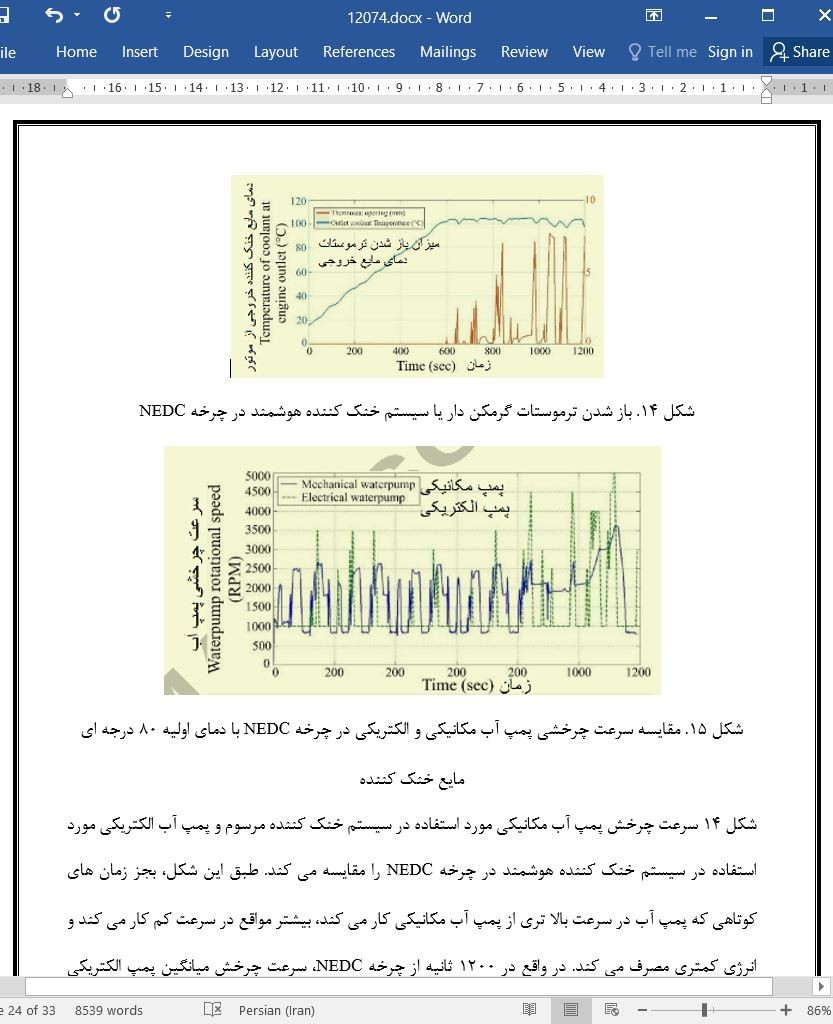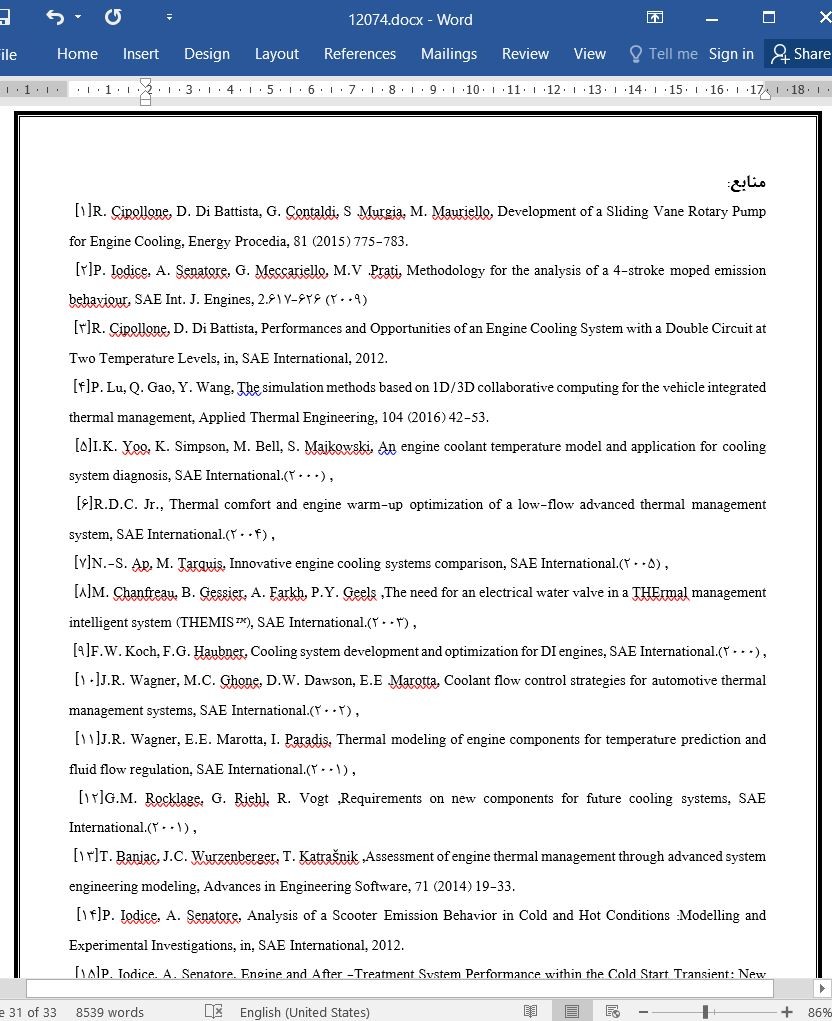
سیستم خنک کننده هوشمند و مدل کنترلی برای بهبود مدیریت حرارتی موتور
چکیده
مدل کنترلی سیستم خنک کننده موتور برای کاهش مصرف سوخت و انتشار گاز های آلاینده موتور توسعه یافته است. این کار با استفاده از اجزای خنک کننده موتور قابل کنترل شامل پمپ آب الکتریکی، فن الکتریکی و ترموستات گرمکن دار انجام شده است. این طرح بر اساس خصوصیات گرفته شده از موتور ۱.۴ لیتری مورد آزمایش می باشد. نتایج شبیه سازی سیستم خنک کننده هوشمند تحت عملکرد چرخه NEDC (استاندارد جدید دوره رانندگی اروپایی) بر اساس استفاده از مدل گرفته شده این موتور با سیستم خنک کننده معمولی مقایسه شده است. نتایج نشانگر کاهش مصرف سوخت به اندازه ۱.۱٪ و کاهش تولید هیدروکربن و کربن مونوکسید به ترتیب به اندازه ۵.۳٪ و ۶.۱٪ می باشد. عملکرد موتور در تمام بخش های چرخه NEDC از جمله گرم کردن و تحت بارگذاری سنگین و سبک، بهبود یافته است. در شرایطی که هنگام شروع به کار کردن موتور، موتور سرد نباشد، استفاده از پمپ آب الکتریکی بسیار سودمند است. به عنوان مثال، اگر دمای اولیه خنک کننده ۸۰ درجه باشد، انرژي مصرفی پمپ آب الکتریکی از نصف انرژي مصرفی پمپ آب مکانیکی کمتر است. اجزای سیستم های خنک کننده مرسوم در شرایط کاری مختلف موتور کارایی کافی نداشته و انرژی بیشتری نیز مصرف می کنند. این امر باعث افزایش مصرف سوخت و تولید گازهای آلاینده بیشتری می شود. با توجه به پتانسیل سیستم خنک کننده خوشمند در کاهش مصرف سوخت و کاهش گازهای آلاینده، تعویض اجزای مکانیکی مرسوم خنک کننده با اجزای قابل کنترل با قابلیت کنترل مستقیم مطلوب خواهد بود.
1 مقدمه
افزایش بازده موتور علاوه بر توانایی کاهش مصرف سوخت، می تواند انتشار گاز های گلخانه ای در محیط را کاهش دهد. به این ترتیب از هر ۲ لحاظ اقتصادی و محیط زیستی مفید است تا تکنولوژی های توسعه و بهبود دهیم که همزمان آلایندگی های محیط زیستی را کاهش داده و بازده موتور را افزایش دهد. تحقیقات مختلف راه حل های متفاوتی برای کاهش آلایندگی هوا بخاطر رفت و آمد های جاده ای پیشنهاد داده اند [1, 2]. در میان این پیشنهادات، تکنولوژی هایی وجود دارند که بر اصلاح خنک کاری موتور و نیاز های حرارتی خودرو متمرکزند [3].
یک روش محتمل قابل توجه برای کاهش آلایندگی هوا، مدیریت شرایط احتراق در یک بازه دمایی بهینه، وابسته به بارگذاری و سرعت موتور می باشد. در این شرایط نه تنها مصرف سوخت کاهش می یابد بلکه آلایندگی هوا نیز با بهبود شرایط عمل احتراق موتور کاهش می یابد.با کنترل دقیق دمای احتراق می توان آلایندگی های تولیدی از احتراق ناقص را کاهش و حتی از بین برد.
Abstract
A controlling model for the cooling system of an engine was developed in order to reduce fuel consumption and engine emissions through the use of controllable engine cooling components including an electrical water pump, an electrical fan, and a heated thermostat. The model was based on engine characteristics that were derived from experiments on a 1.4 L engine. The results of simulations using the derived engine model showed that fuel consumption is decreased 1.1% and hydrocarbon and carbon monoxide emissions are reduced 5.3% and 6.1%, respectively, for the intelligent cooling system under NEDC cycle operation compared to a conventional cooling system. Engine performance was improved over all parts of the NEDC cycle, including engine warm up and both high and low engine load conditions. In non-cold start situations, the integration of an electrical water pump proved especially beneficial. For instance, if the initial coolant temperature is equal to 80 °C, the energy consumption for an electrical water pump is less than half of that of a mechanical water pump. Considering both the potential fuel savings and emission reductions, it is beneficial to substitute the active controllable components described in this work for conventional mechanical components that provide insufficient cooling during various engine operation conditions while requiring greater energy to both increase fuel efficiency and reduce pollutant emissions.
1. Introduction
Increasing engine efficiency can result not only in fuel savings, but also in the reduction of greenhouse gases and other environmental pollutants emitted into the atmosphere. Thus, it can be both economically and environmentally beneficial to develop and improve technologies that can simultaneously reduce environmental pollutants and increase fuel efficiency in engines. Numerous studies have presented different solutions to decrease air pollutants created by road traffic[1, 2]. Among these technologies are those considering a revision of the engine cooling and the thermal needs on board the vehicle [3].
One potentially significant method for reducing air pollution is maintaining combustion conditions within an optimum temperature range related to load and engine speed. In such a case, not only will fuel consumption be reduced, but pollutant emissions will also be reduced by improving combustion operating conditions. By carefully controlling combustion temperature, pollutants resulting from incomplete combustion can be reduced or eliminated.
نکات برجسته
چکیده
1 مقدمه
2 اجزای سیستم خنک کننده هوشمند
۲.۱. فن الکتریکی
۲.۲. ترموستات
۲.۳. پمپ اب الکتریکی
۳. طرح کنترل
۳.۱. تعیین دمای بهینه
۲.۳.طرح کنترل
4 اعتبار سنجی
۵. نتایج شبیه سازی
۶. نتیجه گیری
تشکر
کلید واژه
منابع
Highlights
Abstract
Nomenclature
1. Introduction
2. Components of the intelligent cooling system
2.1. Electrical fan
2.2. Thermostat
2.3. Electrical water pump
3. Control strategy
3.1. Determining optimal temperature
3.2. Control model
4. Validation
5. Simulation results
6. Conclusions
Acknowledgments
References
- اصل مقاله انگلیسی با فرمت ورد (word) با قابلیت ویرایش
- ترجمه فارسی مقاله با فرمت ورد (word) با قابلیت ویرایش، بدون آرم سایت ای ترجمه
- ترجمه فارسی مقاله با فرمت pdf، بدون آرم سایت ای ترجمه



